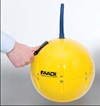Drifting Buoys From AADI Follow Oil Slicks And Save Lives

In May 2008 AADI (Aanderaa Data Instruments AS) entered an agreement with NOFO (The Norwegian Clean Sea Association for Operating Companies) to develop a small drifting buoy that has similar drift characteristics as an oil slick on the sea surface. Information from the Drifting Buoys are transferred by AIS and displayed on the electronic chart system onboard any vessel that has up-to-date ECDIS software according to IMO standards.
During 2009 the buoy, with a diameter of approximately 30 cm, has been tested in a number of different oil spill exercises as well as in man overboard exercises and other types of exercise. According to the design specifications the vessels should be able to pick up the AIS signals from the buoy at a distance of at least 3 nautical miles, the tests have shown that good signals were picked up at a distance of 7 nautical miles with wave heights of 10 meters and 12 nautical miles on a calm sea. Drop tests confirmed that the buoy will withstand a drop from the specified altitude of 50 meters above sea level, which makes it possible to drop from a fixed installation or from a helicopter.
During an oil spill exercise at the Frigg Field in the North Sea in early June 2009 the AIS Drifting Buoys were used to track remnant oil slicks that were escaping from the main spill. In the test report you can read the following:
"On Thursday morning, the reconnaissance airplane returns to the Frigg Field to locate and map the leftovers from the oil recovery exercise that was conducted on Tuesday and Wednesday. After concentrating the search around the vessels it headed to the AIS Oil Drifting Buoys. The airplane has the buoys on its electronic chart and flies straight to them. The airplane reports a thin heavy oil slick (6 to 8 m²) around buoy serial no.17 and a thin oil slick (blue sheen) approximately 2NM from buoy serial no. 15, which correlates with the buoy's calculated drift speed considering the two hour delayed deployment of buoy serial no. 15".
Other tests were performed by the Norwegian Coast Guard vessel "KV Harstad" off the coast of northern Norway. Lieutenant-Commander Odvin Nilsen, Captain of the KV Harstad, gave this report:
"We launched a 20 feet container, a small sailing boat and a dummy person and observed the drift of these objects based on influence from wind and currents over several days. One AI S buoy was attached to the dummy person and one buoy floated freely on the surface. We observed that the freely floating AIS buoy was drifting quite similarly to the buoy that was attached to the dummy person. The dummy was floating horizontally simulating a person wearing a survival suit"
SOURCE: AADI
